Analysis of Case Study as Transformational Leadership
VerifiedAdded on 2023/02/01
|15
|4015
|95
AI Summary
This assignment analyzes the case study as transformational leadership and discusses the strengths of Dr. Cook on the Full-Range Model of Leadership.
Contribute Materials
Your contribution can guide someone’s learning journey. Share your
documents today.
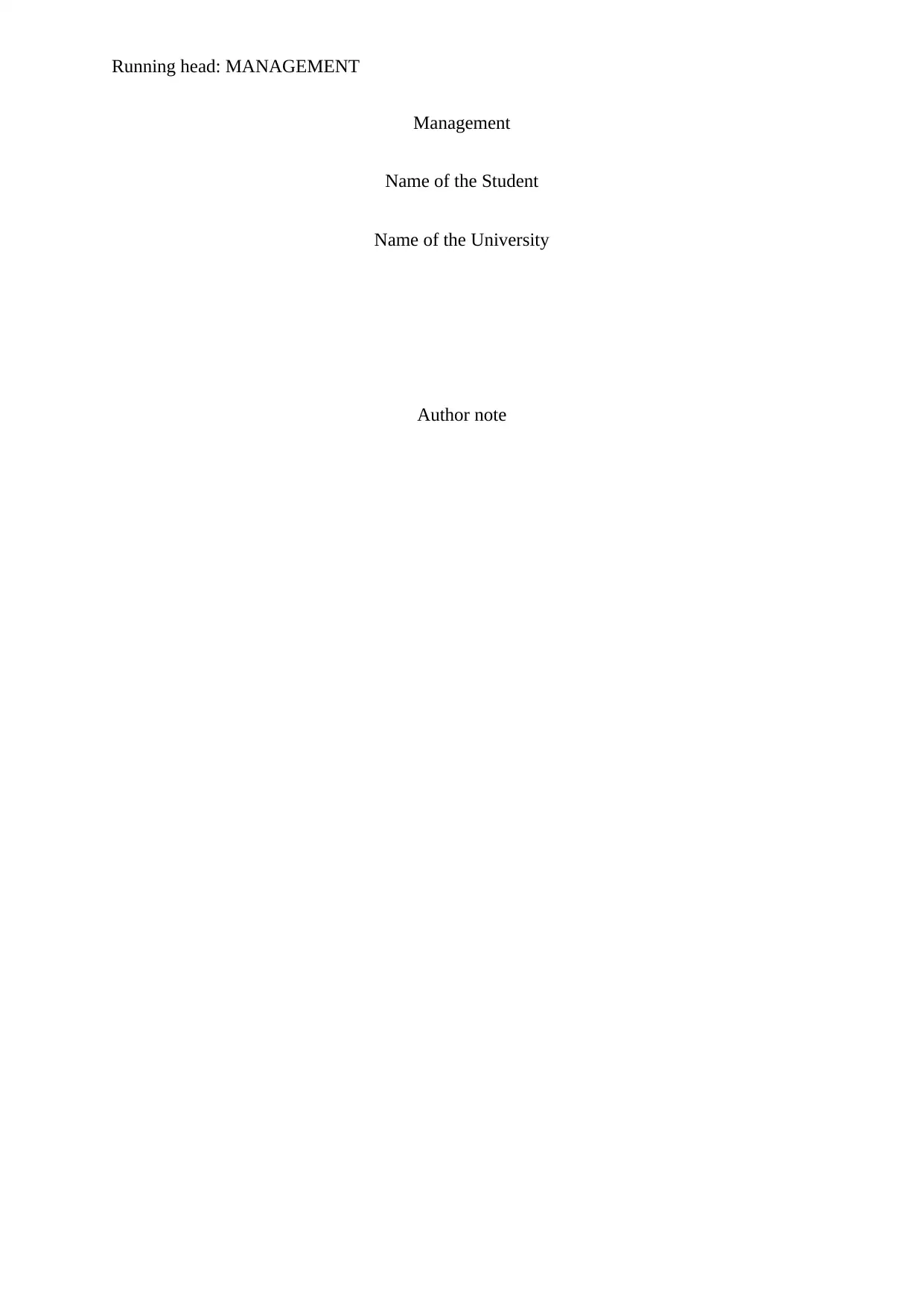
Running head: MANAGEMENT
Management
Name of the Student
Name of the University
Author note
Management
Name of the Student
Name of the University
Author note
Secure Best Marks with AI Grader
Need help grading? Try our AI Grader for instant feedback on your assignments.
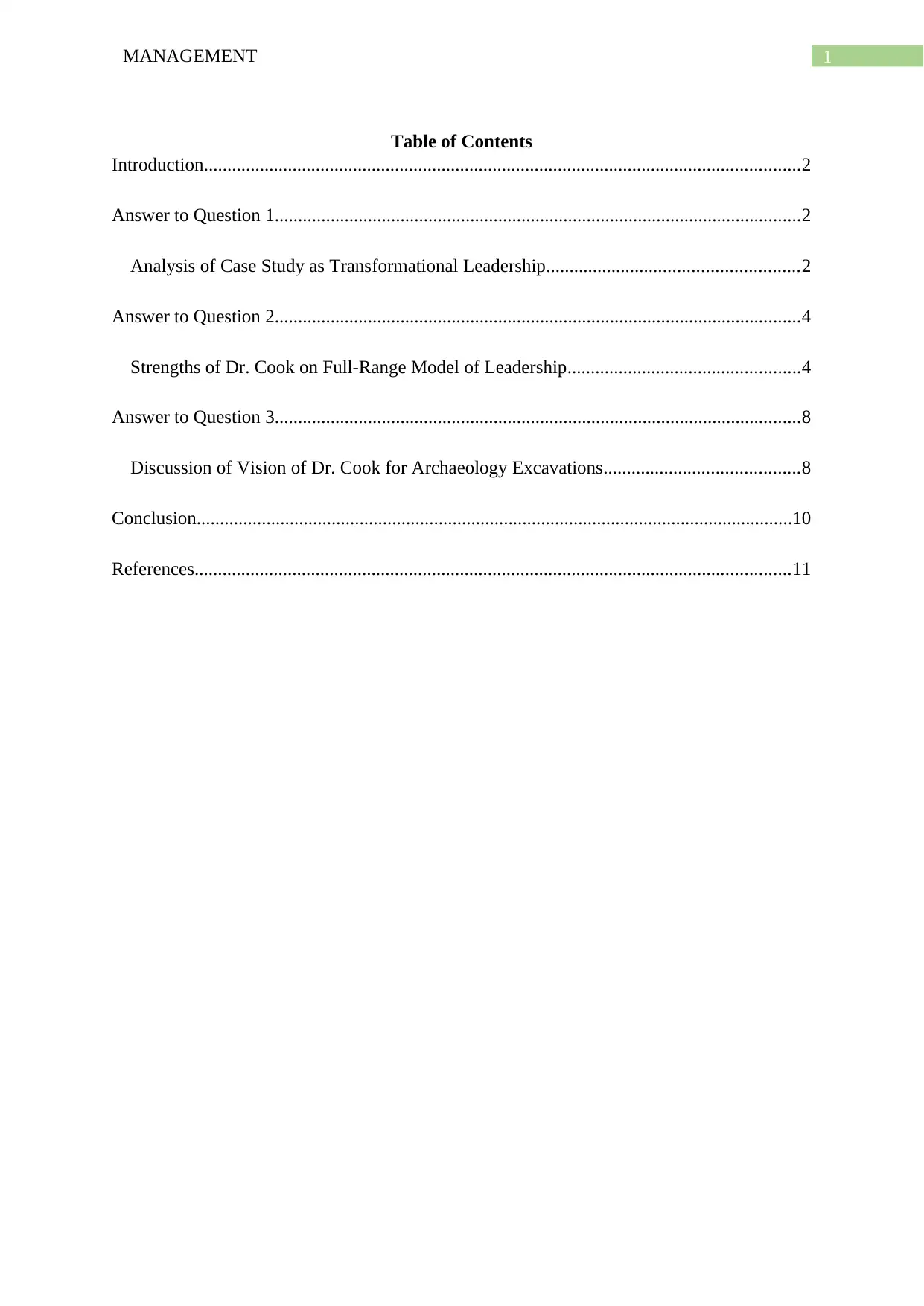
1MANAGEMENT
Table of Contents
Introduction................................................................................................................................2
Answer to Question 1.................................................................................................................2
Analysis of Case Study as Transformational Leadership......................................................2
Answer to Question 2.................................................................................................................4
Strengths of Dr. Cook on Full-Range Model of Leadership..................................................4
Answer to Question 3.................................................................................................................8
Discussion of Vision of Dr. Cook for Archaeology Excavations..........................................8
Conclusion................................................................................................................................10
References................................................................................................................................11
Table of Contents
Introduction................................................................................................................................2
Answer to Question 1.................................................................................................................2
Analysis of Case Study as Transformational Leadership......................................................2
Answer to Question 2.................................................................................................................4
Strengths of Dr. Cook on Full-Range Model of Leadership..................................................4
Answer to Question 3.................................................................................................................8
Discussion of Vision of Dr. Cook for Archaeology Excavations..........................................8
Conclusion................................................................................................................................10
References................................................................................................................................11
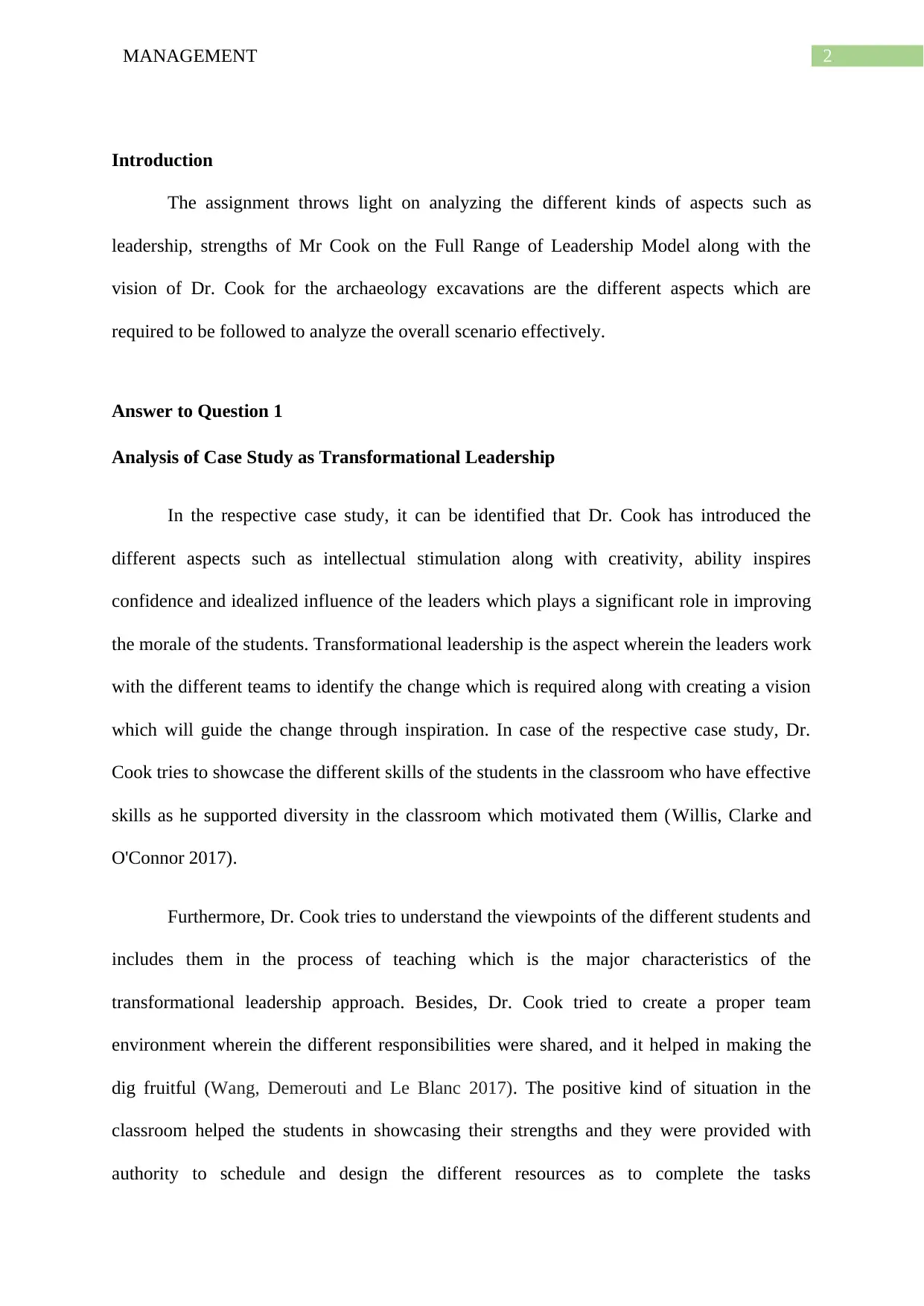
2MANAGEMENT
Introduction
The assignment throws light on analyzing the different kinds of aspects such as
leadership, strengths of Mr Cook on the Full Range of Leadership Model along with the
vision of Dr. Cook for the archaeology excavations are the different aspects which are
required to be followed to analyze the overall scenario effectively.
Answer to Question 1
Analysis of Case Study as Transformational Leadership
In the respective case study, it can be identified that Dr. Cook has introduced the
different aspects such as intellectual stimulation along with creativity, ability inspires
confidence and idealized influence of the leaders which plays a significant role in improving
the morale of the students. Transformational leadership is the aspect wherein the leaders work
with the different teams to identify the change which is required along with creating a vision
which will guide the change through inspiration. In case of the respective case study, Dr.
Cook tries to showcase the different skills of the students in the classroom who have effective
skills as he supported diversity in the classroom which motivated them (Willis, Clarke and
O'Connor 2017).
Furthermore, Dr. Cook tries to understand the viewpoints of the different students and
includes them in the process of teaching which is the major characteristics of the
transformational leadership approach. Besides, Dr. Cook tried to create a proper team
environment wherein the different responsibilities were shared, and it helped in making the
dig fruitful (Wang, Demerouti and Le Blanc 2017). The positive kind of situation in the
classroom helped the students in showcasing their strengths and they were provided with
authority to schedule and design the different resources as to complete the tasks
Introduction
The assignment throws light on analyzing the different kinds of aspects such as
leadership, strengths of Mr Cook on the Full Range of Leadership Model along with the
vision of Dr. Cook for the archaeology excavations are the different aspects which are
required to be followed to analyze the overall scenario effectively.
Answer to Question 1
Analysis of Case Study as Transformational Leadership
In the respective case study, it can be identified that Dr. Cook has introduced the
different aspects such as intellectual stimulation along with creativity, ability inspires
confidence and idealized influence of the leaders which plays a significant role in improving
the morale of the students. Transformational leadership is the aspect wherein the leaders work
with the different teams to identify the change which is required along with creating a vision
which will guide the change through inspiration. In case of the respective case study, Dr.
Cook tries to showcase the different skills of the students in the classroom who have effective
skills as he supported diversity in the classroom which motivated them (Willis, Clarke and
O'Connor 2017).
Furthermore, Dr. Cook tries to understand the viewpoints of the different students and
includes them in the process of teaching which is the major characteristics of the
transformational leadership approach. Besides, Dr. Cook tried to create a proper team
environment wherein the different responsibilities were shared, and it helped in making the
dig fruitful (Wang, Demerouti and Le Blanc 2017). The positive kind of situation in the
classroom helped the students in showcasing their strengths and they were provided with
authority to schedule and design the different resources as to complete the tasks
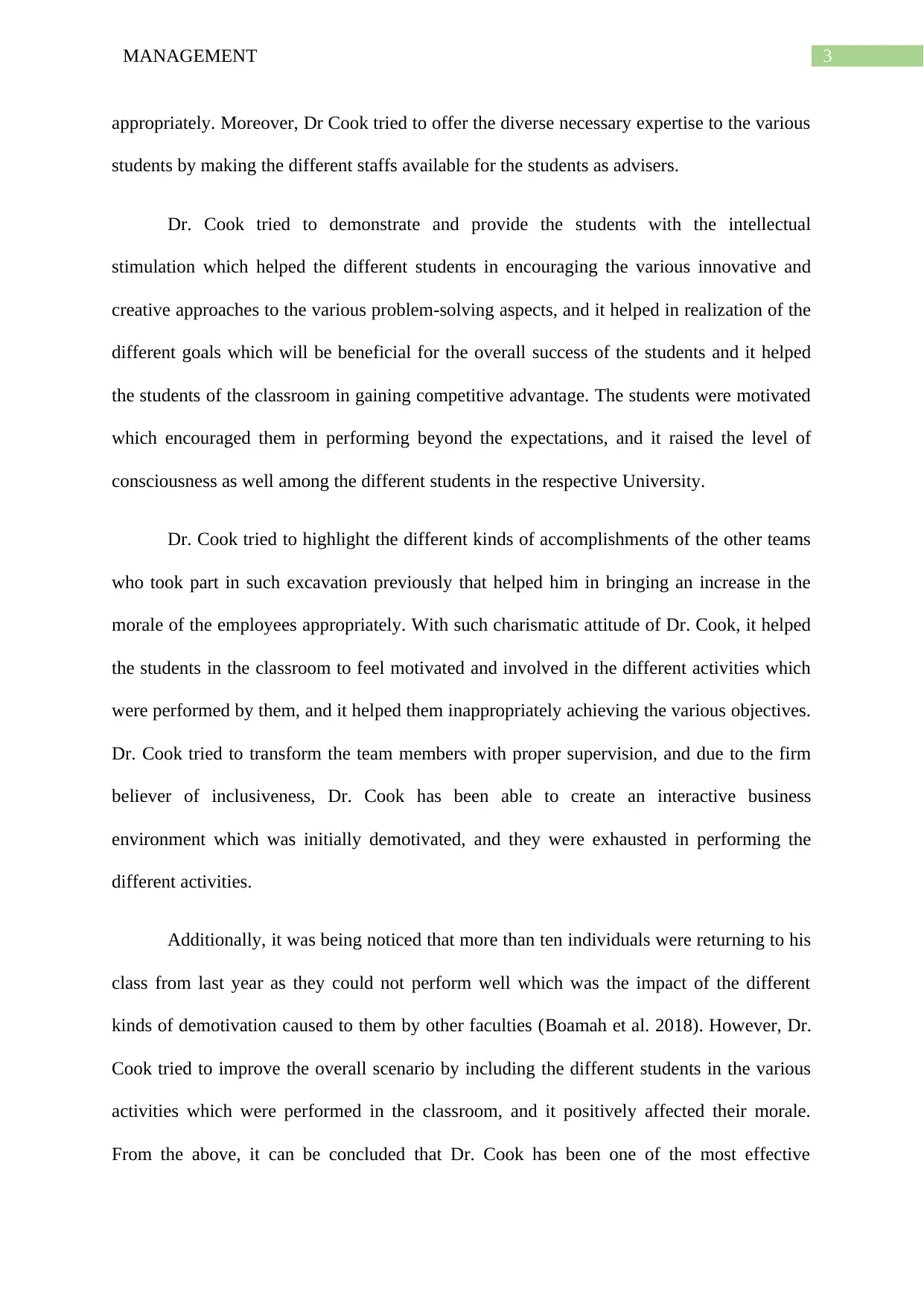
3MANAGEMENT
appropriately. Moreover, Dr Cook tried to offer the diverse necessary expertise to the various
students by making the different staffs available for the students as advisers.
Dr. Cook tried to demonstrate and provide the students with the intellectual
stimulation which helped the different students in encouraging the various innovative and
creative approaches to the various problem-solving aspects, and it helped in realization of the
different goals which will be beneficial for the overall success of the students and it helped
the students of the classroom in gaining competitive advantage. The students were motivated
which encouraged them in performing beyond the expectations, and it raised the level of
consciousness as well among the different students in the respective University.
Dr. Cook tried to highlight the different kinds of accomplishments of the other teams
who took part in such excavation previously that helped him in bringing an increase in the
morale of the employees appropriately. With such charismatic attitude of Dr. Cook, it helped
the students in the classroom to feel motivated and involved in the different activities which
were performed by them, and it helped them inappropriately achieving the various objectives.
Dr. Cook tried to transform the team members with proper supervision, and due to the firm
believer of inclusiveness, Dr. Cook has been able to create an interactive business
environment which was initially demotivated, and they were exhausted in performing the
different activities.
Additionally, it was being noticed that more than ten individuals were returning to his
class from last year as they could not perform well which was the impact of the different
kinds of demotivation caused to them by other faculties (Boamah et al. 2018). However, Dr.
Cook tried to improve the overall scenario by including the different students in the various
activities which were performed in the classroom, and it positively affected their morale.
From the above, it can be concluded that Dr. Cook has been one of the most effective
appropriately. Moreover, Dr Cook tried to offer the diverse necessary expertise to the various
students by making the different staffs available for the students as advisers.
Dr. Cook tried to demonstrate and provide the students with the intellectual
stimulation which helped the different students in encouraging the various innovative and
creative approaches to the various problem-solving aspects, and it helped in realization of the
different goals which will be beneficial for the overall success of the students and it helped
the students of the classroom in gaining competitive advantage. The students were motivated
which encouraged them in performing beyond the expectations, and it raised the level of
consciousness as well among the different students in the respective University.
Dr. Cook tried to highlight the different kinds of accomplishments of the other teams
who took part in such excavation previously that helped him in bringing an increase in the
morale of the employees appropriately. With such charismatic attitude of Dr. Cook, it helped
the students in the classroom to feel motivated and involved in the different activities which
were performed by them, and it helped them inappropriately achieving the various objectives.
Dr. Cook tried to transform the team members with proper supervision, and due to the firm
believer of inclusiveness, Dr. Cook has been able to create an interactive business
environment which was initially demotivated, and they were exhausted in performing the
different activities.
Additionally, it was being noticed that more than ten individuals were returning to his
class from last year as they could not perform well which was the impact of the different
kinds of demotivation caused to them by other faculties (Boamah et al. 2018). However, Dr.
Cook tried to improve the overall scenario by including the different students in the various
activities which were performed in the classroom, and it positively affected their morale.
From the above, it can be concluded that Dr. Cook has been one of the most effective
Secure Best Marks with AI Grader
Need help grading? Try our AI Grader for instant feedback on your assignments.
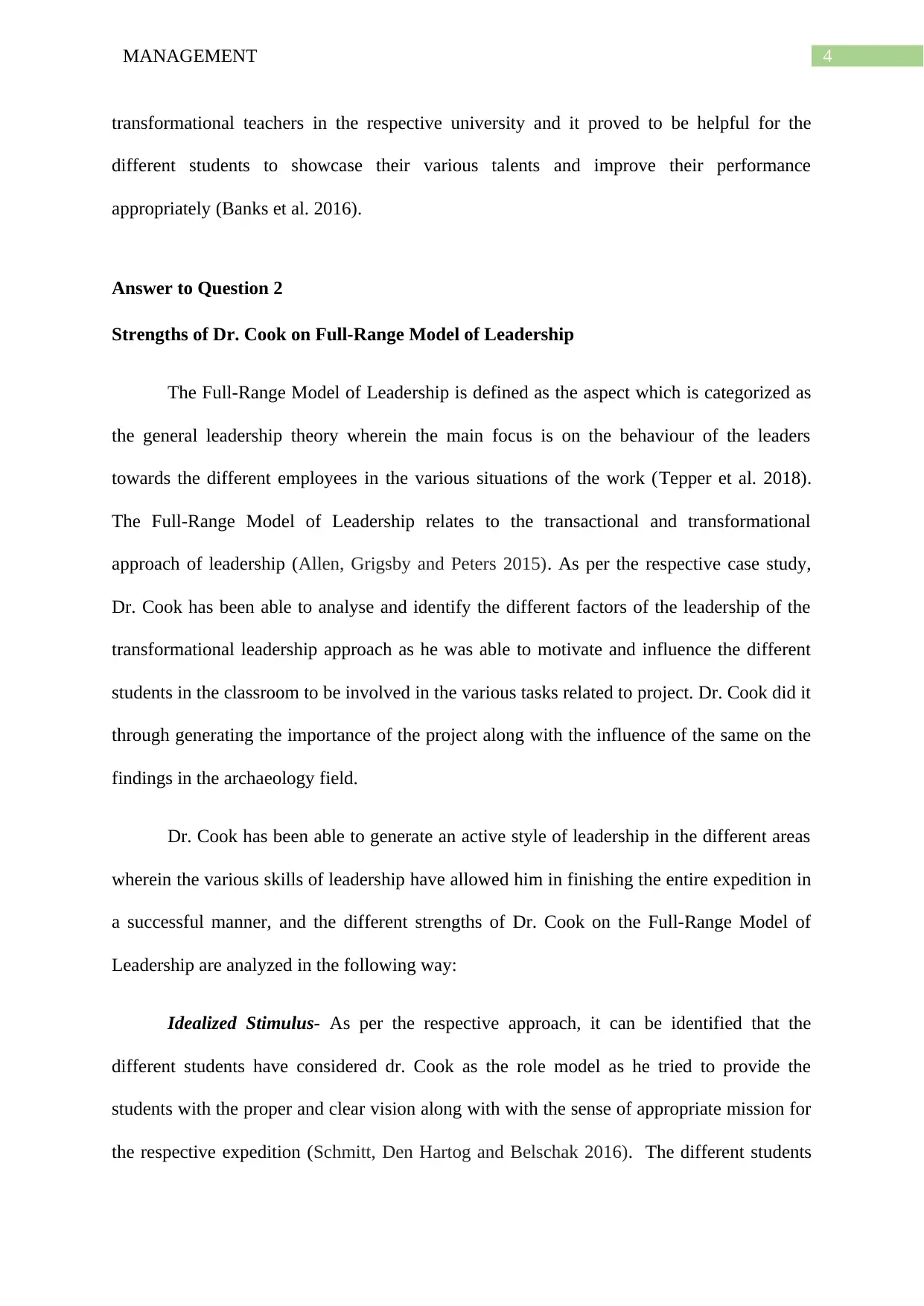
4MANAGEMENT
transformational teachers in the respective university and it proved to be helpful for the
different students to showcase their various talents and improve their performance
appropriately (Banks et al. 2016).
Answer to Question 2
Strengths of Dr. Cook on Full-Range Model of Leadership
The Full-Range Model of Leadership is defined as the aspect which is categorized as
the general leadership theory wherein the main focus is on the behaviour of the leaders
towards the different employees in the various situations of the work (Tepper et al. 2018).
The Full-Range Model of Leadership relates to the transactional and transformational
approach of leadership (Allen, Grigsby and Peters 2015). As per the respective case study,
Dr. Cook has been able to analyse and identify the different factors of the leadership of the
transformational leadership approach as he was able to motivate and influence the different
students in the classroom to be involved in the various tasks related to project. Dr. Cook did it
through generating the importance of the project along with the influence of the same on the
findings in the archaeology field.
Dr. Cook has been able to generate an active style of leadership in the different areas
wherein the various skills of leadership have allowed him in finishing the entire expedition in
a successful manner, and the different strengths of Dr. Cook on the Full-Range Model of
Leadership are analyzed in the following way:
Idealized Stimulus- As per the respective approach, it can be identified that the
different students have considered dr. Cook as the role model as he tried to provide the
students with the proper and clear vision along with with the sense of appropriate mission for
the respective expedition (Schmitt, Den Hartog and Belschak 2016). The different students
transformational teachers in the respective university and it proved to be helpful for the
different students to showcase their various talents and improve their performance
appropriately (Banks et al. 2016).
Answer to Question 2
Strengths of Dr. Cook on Full-Range Model of Leadership
The Full-Range Model of Leadership is defined as the aspect which is categorized as
the general leadership theory wherein the main focus is on the behaviour of the leaders
towards the different employees in the various situations of the work (Tepper et al. 2018).
The Full-Range Model of Leadership relates to the transactional and transformational
approach of leadership (Allen, Grigsby and Peters 2015). As per the respective case study,
Dr. Cook has been able to analyse and identify the different factors of the leadership of the
transformational leadership approach as he was able to motivate and influence the different
students in the classroom to be involved in the various tasks related to project. Dr. Cook did it
through generating the importance of the project along with the influence of the same on the
findings in the archaeology field.
Dr. Cook has been able to generate an active style of leadership in the different areas
wherein the various skills of leadership have allowed him in finishing the entire expedition in
a successful manner, and the different strengths of Dr. Cook on the Full-Range Model of
Leadership are analyzed in the following way:
Idealized Stimulus- As per the respective approach, it can be identified that the
different students have considered dr. Cook as the role model as he tried to provide the
students with the proper and clear vision along with with the sense of appropriate mission for
the respective expedition (Schmitt, Den Hartog and Belschak 2016). The different students
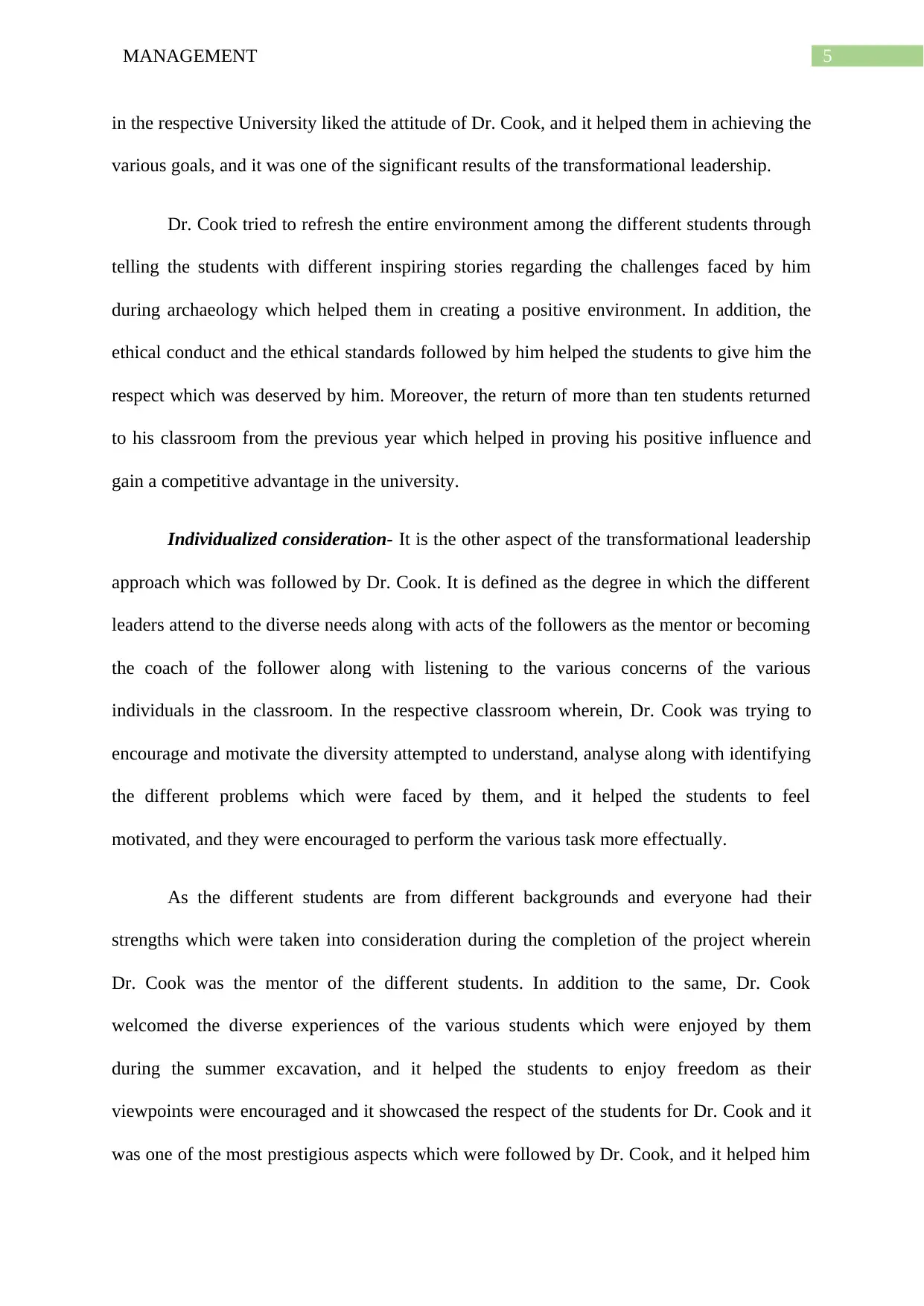
5MANAGEMENT
in the respective University liked the attitude of Dr. Cook, and it helped them in achieving the
various goals, and it was one of the significant results of the transformational leadership.
Dr. Cook tried to refresh the entire environment among the different students through
telling the students with different inspiring stories regarding the challenges faced by him
during archaeology which helped them in creating a positive environment. In addition, the
ethical conduct and the ethical standards followed by him helped the students to give him the
respect which was deserved by him. Moreover, the return of more than ten students returned
to his classroom from the previous year which helped in proving his positive influence and
gain a competitive advantage in the university.
Individualized consideration- It is the other aspect of the transformational leadership
approach which was followed by Dr. Cook. It is defined as the degree in which the different
leaders attend to the diverse needs along with acts of the followers as the mentor or becoming
the coach of the follower along with listening to the various concerns of the various
individuals in the classroom. In the respective classroom wherein, Dr. Cook was trying to
encourage and motivate the diversity attempted to understand, analyse along with identifying
the different problems which were faced by them, and it helped the students to feel
motivated, and they were encouraged to perform the various task more effectually.
As the different students are from different backgrounds and everyone had their
strengths which were taken into consideration during the completion of the project wherein
Dr. Cook was the mentor of the different students. In addition to the same, Dr. Cook
welcomed the diverse experiences of the various students which were enjoyed by them
during the summer excavation, and it helped the students to enjoy freedom as their
viewpoints were encouraged and it showcased the respect of the students for Dr. Cook and it
was one of the most prestigious aspects which were followed by Dr. Cook, and it helped him
in the respective University liked the attitude of Dr. Cook, and it helped them in achieving the
various goals, and it was one of the significant results of the transformational leadership.
Dr. Cook tried to refresh the entire environment among the different students through
telling the students with different inspiring stories regarding the challenges faced by him
during archaeology which helped them in creating a positive environment. In addition, the
ethical conduct and the ethical standards followed by him helped the students to give him the
respect which was deserved by him. Moreover, the return of more than ten students returned
to his classroom from the previous year which helped in proving his positive influence and
gain a competitive advantage in the university.
Individualized consideration- It is the other aspect of the transformational leadership
approach which was followed by Dr. Cook. It is defined as the degree in which the different
leaders attend to the diverse needs along with acts of the followers as the mentor or becoming
the coach of the follower along with listening to the various concerns of the various
individuals in the classroom. In the respective classroom wherein, Dr. Cook was trying to
encourage and motivate the diversity attempted to understand, analyse along with identifying
the different problems which were faced by them, and it helped the students to feel
motivated, and they were encouraged to perform the various task more effectually.
As the different students are from different backgrounds and everyone had their
strengths which were taken into consideration during the completion of the project wherein
Dr. Cook was the mentor of the different students. In addition to the same, Dr. Cook
welcomed the diverse experiences of the various students which were enjoyed by them
during the summer excavation, and it helped the students to enjoy freedom as their
viewpoints were encouraged and it showcased the respect of the students for Dr. Cook and it
was one of the most prestigious aspects which were followed by Dr. Cook, and it helped him

6MANAGEMENT
in improving the morale of the different students (Rosenbach 2018). Moreover, Dr. Cook
tried to invite more than ten students who were the students from the previous year; however
the expedition was particularly disjointed.
Inspirational Motivation- It is the third aspect wherein Dr. Cook tried to provide
huge motivation among the different students who were in the classroom. From the respective
case study, it can be identified that different students from the previous year were
demotivated and they did not have positive morale to perform the various tasks (Nguyen et al.
2017). However, Dr. Cook tried to successfully motivate and influence the different students
in a positive manner which increased their morale and improved the tasks.
In performing the respective project, Dr. Cook tried to provide the different students
with the opportunity to share their thoughts for improvement and the requirements of the
change. In addition, Dr. Cook allowed the diverse students who were involved in the project
to take part in the expedition and each were allowed to take part in the various activities in
which they knew, and Dr. Cook encouraged the contribution of every individual (Mittal and
Dhar 2015).
Intellectual Stimulation- The main motive of Dr. Cook was to teach the different
students on archaeology and with the different stories which were discussed by him helped
him in motivating the different students through proper sharing of the various past digs along
with highlighting the various accomplishments which were made by the student (Mathew and
Gupta 2015). Moreover, Dr. Cook tried to share the different kinds of interest in the project
and analysis of the various aspects through which the team can be successful in the respective
essential project.
In addition, Dr. Cook has been able to design the technique wherein he allowed the
different students to showcase their different approaches and they were provided with
in improving the morale of the different students (Rosenbach 2018). Moreover, Dr. Cook
tried to invite more than ten students who were the students from the previous year; however
the expedition was particularly disjointed.
Inspirational Motivation- It is the third aspect wherein Dr. Cook tried to provide
huge motivation among the different students who were in the classroom. From the respective
case study, it can be identified that different students from the previous year were
demotivated and they did not have positive morale to perform the various tasks (Nguyen et al.
2017). However, Dr. Cook tried to successfully motivate and influence the different students
in a positive manner which increased their morale and improved the tasks.
In performing the respective project, Dr. Cook tried to provide the different students
with the opportunity to share their thoughts for improvement and the requirements of the
change. In addition, Dr. Cook allowed the diverse students who were involved in the project
to take part in the expedition and each were allowed to take part in the various activities in
which they knew, and Dr. Cook encouraged the contribution of every individual (Mittal and
Dhar 2015).
Intellectual Stimulation- The main motive of Dr. Cook was to teach the different
students on archaeology and with the different stories which were discussed by him helped
him in motivating the different students through proper sharing of the various past digs along
with highlighting the various accomplishments which were made by the student (Mathew and
Gupta 2015). Moreover, Dr. Cook tried to share the different kinds of interest in the project
and analysis of the various aspects through which the team can be successful in the respective
essential project.
In addition, Dr. Cook has been able to design the technique wherein he allowed the
different students to showcase their different approaches and they were provided with
Paraphrase This Document
Need a fresh take? Get an instant paraphrase of this document with our AI Paraphraser
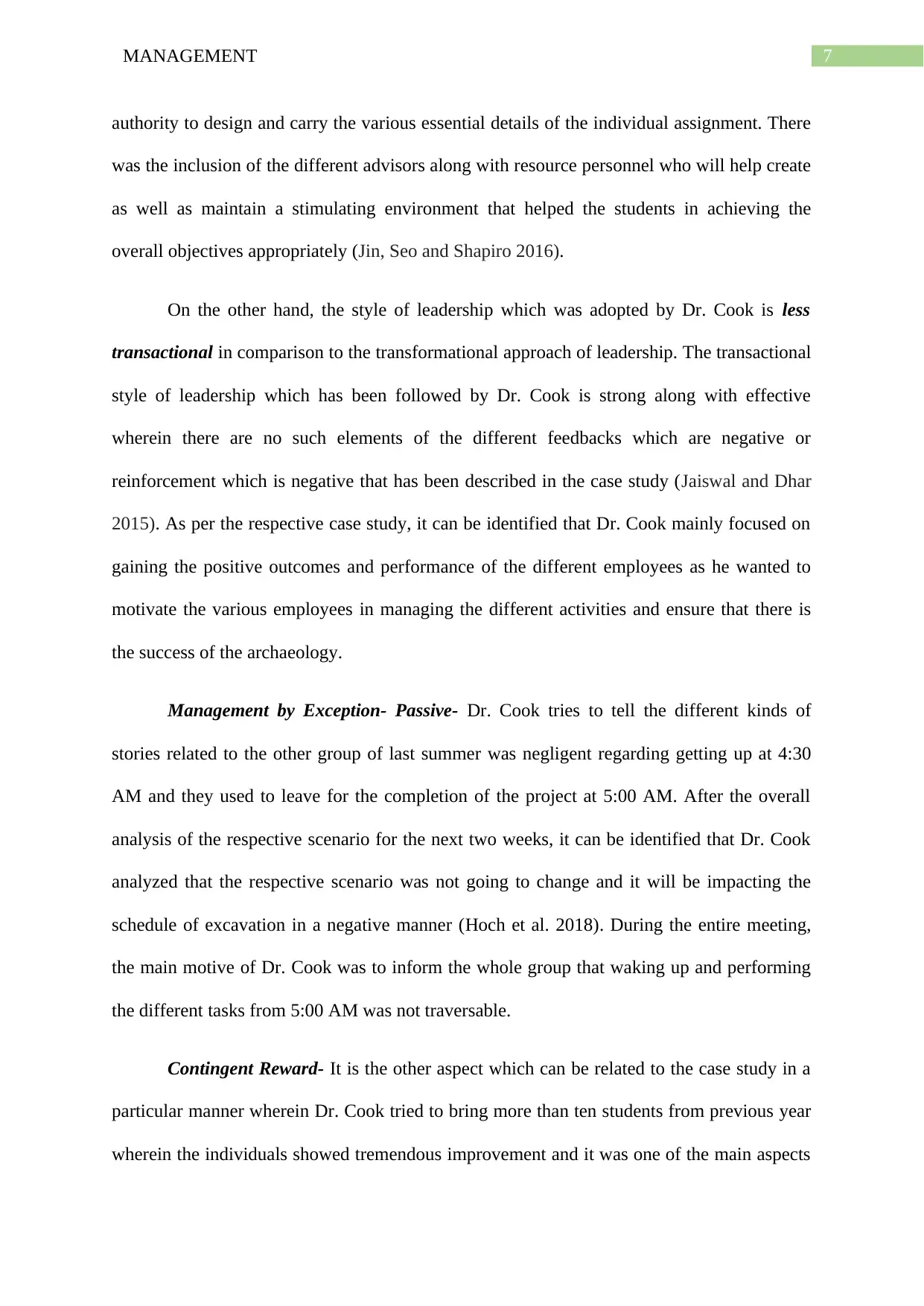
7MANAGEMENT
authority to design and carry the various essential details of the individual assignment. There
was the inclusion of the different advisors along with resource personnel who will help create
as well as maintain a stimulating environment that helped the students in achieving the
overall objectives appropriately (Jin, Seo and Shapiro 2016).
On the other hand, the style of leadership which was adopted by Dr. Cook is less
transactional in comparison to the transformational approach of leadership. The transactional
style of leadership which has been followed by Dr. Cook is strong along with effective
wherein there are no such elements of the different feedbacks which are negative or
reinforcement which is negative that has been described in the case study (Jaiswal and Dhar
2015). As per the respective case study, it can be identified that Dr. Cook mainly focused on
gaining the positive outcomes and performance of the different employees as he wanted to
motivate the various employees in managing the different activities and ensure that there is
the success of the archaeology.
Management by Exception- Passive- Dr. Cook tries to tell the different kinds of
stories related to the other group of last summer was negligent regarding getting up at 4:30
AM and they used to leave for the completion of the project at 5:00 AM. After the overall
analysis of the respective scenario for the next two weeks, it can be identified that Dr. Cook
analyzed that the respective scenario was not going to change and it will be impacting the
schedule of excavation in a negative manner (Hoch et al. 2018). During the entire meeting,
the main motive of Dr. Cook was to inform the whole group that waking up and performing
the different tasks from 5:00 AM was not traversable.
Contingent Reward- It is the other aspect which can be related to the case study in a
particular manner wherein Dr. Cook tried to bring more than ten students from previous year
wherein the individuals showed tremendous improvement and it was one of the main aspects
authority to design and carry the various essential details of the individual assignment. There
was the inclusion of the different advisors along with resource personnel who will help create
as well as maintain a stimulating environment that helped the students in achieving the
overall objectives appropriately (Jin, Seo and Shapiro 2016).
On the other hand, the style of leadership which was adopted by Dr. Cook is less
transactional in comparison to the transformational approach of leadership. The transactional
style of leadership which has been followed by Dr. Cook is strong along with effective
wherein there are no such elements of the different feedbacks which are negative or
reinforcement which is negative that has been described in the case study (Jaiswal and Dhar
2015). As per the respective case study, it can be identified that Dr. Cook mainly focused on
gaining the positive outcomes and performance of the different employees as he wanted to
motivate the various employees in managing the different activities and ensure that there is
the success of the archaeology.
Management by Exception- Passive- Dr. Cook tries to tell the different kinds of
stories related to the other group of last summer was negligent regarding getting up at 4:30
AM and they used to leave for the completion of the project at 5:00 AM. After the overall
analysis of the respective scenario for the next two weeks, it can be identified that Dr. Cook
analyzed that the respective scenario was not going to change and it will be impacting the
schedule of excavation in a negative manner (Hoch et al. 2018). During the entire meeting,
the main motive of Dr. Cook was to inform the whole group that waking up and performing
the different tasks from 5:00 AM was not traversable.
Contingent Reward- It is the other aspect which can be related to the case study in a
particular manner wherein Dr. Cook tried to bring more than ten students from previous year
wherein the individuals showed tremendous improvement and it was one of the main aspects

8MANAGEMENT
which were undertaken by Dr. Cook, and it helped them in positively managing the different
activities (Hetland et al. 2018). Those ten students who were demotivated and did not
perform well previously were able to improve the various skills and gain a competitive
advantage in the market.
On the other hand, there are different non-leadership approaches which were followed
by Dr. Cook, and it helped him receiving respect, and the morale of the different students was
improved. As per the Laissez-Faire style of leadership, it can be identified that the leaders
are hands off and they allow the different members in the group to make the various decisions
which increase the morale of the employees and the entire performance is improved and
generate positive results (Hawkins 2017). As per the respective case study, Dr. Cook allowed
the different students to showcase their opinions, and he respected their opinions and
decisions which helped him in positively achieving the goals. Due to the following of the
particular leadership style, the productivity among the students was positive and gained a
competitive advantage.
Answer to Question 3
Discussion of Vision of Dr. Cook for Archaeology Excavations
From the respective case study, it can be identified and analyzed that there are
different kinds of vision of Dr. Cook that will be helpful for the excavation for archaeology.
The main aim and motive of Dr. Cook are to excel his interests in the different kinds of
scholarly works which are based on archaeology which are mainly based on the various
outcomes of the respective expedition (Ghasabeh, Soosay and Reaiche 2015). The main
aspect which was followed by Dr. Cook was to inspire along with teaching the different
students involved in the respective subject through explanation of the respective expeditions.
The main vision of the company is to educate the entire world through the different findings
which were undertaken by Dr. Cook, and it helped them in positively managing the different
activities (Hetland et al. 2018). Those ten students who were demotivated and did not
perform well previously were able to improve the various skills and gain a competitive
advantage in the market.
On the other hand, there are different non-leadership approaches which were followed
by Dr. Cook, and it helped him receiving respect, and the morale of the different students was
improved. As per the Laissez-Faire style of leadership, it can be identified that the leaders
are hands off and they allow the different members in the group to make the various decisions
which increase the morale of the employees and the entire performance is improved and
generate positive results (Hawkins 2017). As per the respective case study, Dr. Cook allowed
the different students to showcase their opinions, and he respected their opinions and
decisions which helped him in positively achieving the goals. Due to the following of the
particular leadership style, the productivity among the students was positive and gained a
competitive advantage.
Answer to Question 3
Discussion of Vision of Dr. Cook for Archaeology Excavations
From the respective case study, it can be identified and analyzed that there are
different kinds of vision of Dr. Cook that will be helpful for the excavation for archaeology.
The main aim and motive of Dr. Cook are to excel his interests in the different kinds of
scholarly works which are based on archaeology which are mainly based on the various
outcomes of the respective expedition (Ghasabeh, Soosay and Reaiche 2015). The main
aspect which was followed by Dr. Cook was to inspire along with teaching the different
students involved in the respective subject through explanation of the respective expeditions.
The main vision of the company is to educate the entire world through the different findings
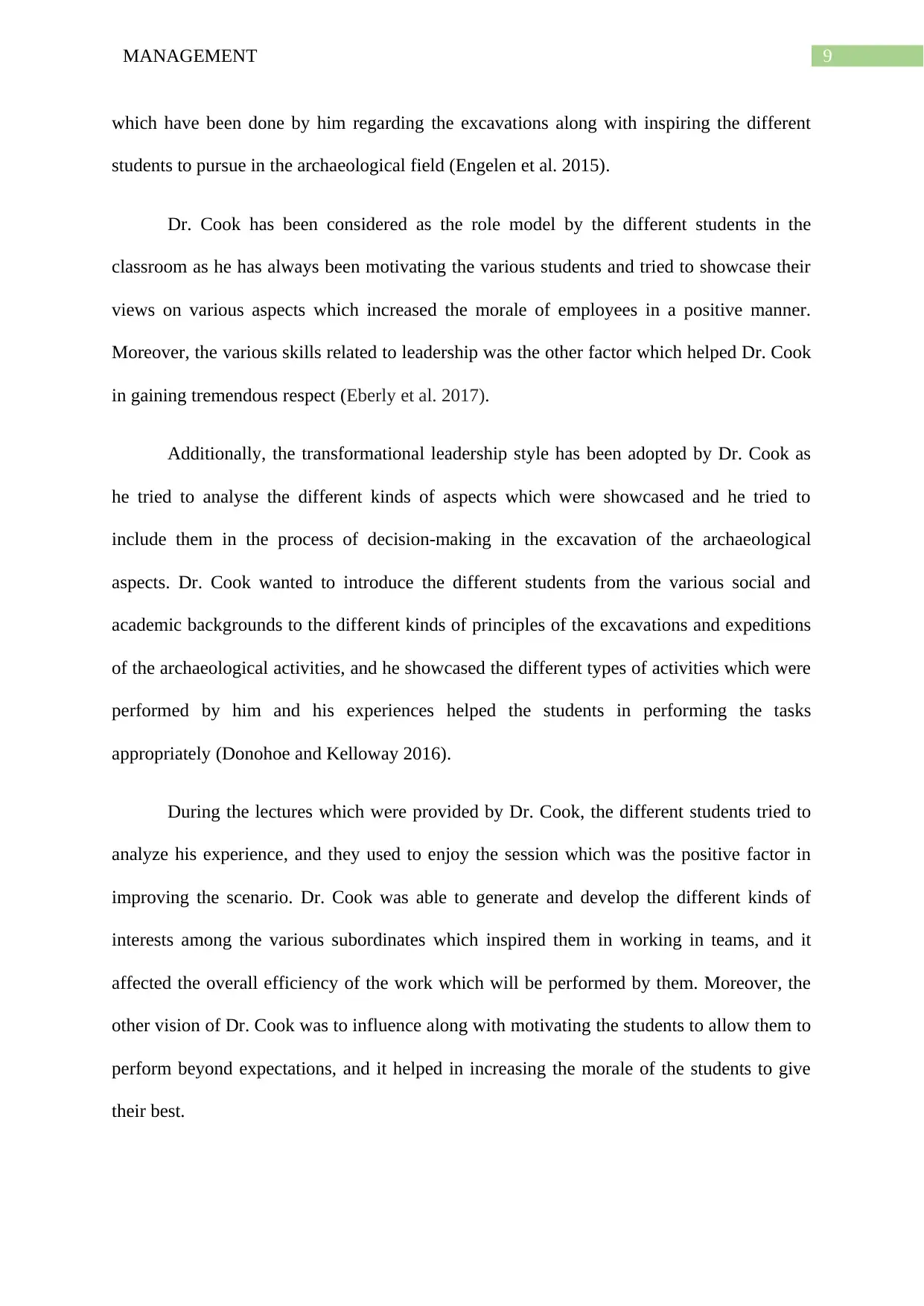
9MANAGEMENT
which have been done by him regarding the excavations along with inspiring the different
students to pursue in the archaeological field (Engelen et al. 2015).
Dr. Cook has been considered as the role model by the different students in the
classroom as he has always been motivating the various students and tried to showcase their
views on various aspects which increased the morale of employees in a positive manner.
Moreover, the various skills related to leadership was the other factor which helped Dr. Cook
in gaining tremendous respect (Eberly et al. 2017).
Additionally, the transformational leadership style has been adopted by Dr. Cook as
he tried to analyse the different kinds of aspects which were showcased and he tried to
include them in the process of decision-making in the excavation of the archaeological
aspects. Dr. Cook wanted to introduce the different students from the various social and
academic backgrounds to the different kinds of principles of the excavations and expeditions
of the archaeological activities, and he showcased the different types of activities which were
performed by him and his experiences helped the students in performing the tasks
appropriately (Donohoe and Kelloway 2016).
During the lectures which were provided by Dr. Cook, the different students tried to
analyze his experience, and they used to enjoy the session which was the positive factor in
improving the scenario. Dr. Cook was able to generate and develop the different kinds of
interests among the various subordinates which inspired them in working in teams, and it
affected the overall efficiency of the work which will be performed by them. Moreover, the
other vision of Dr. Cook was to influence along with motivating the students to allow them to
perform beyond expectations, and it helped in increasing the morale of the students to give
their best.
which have been done by him regarding the excavations along with inspiring the different
students to pursue in the archaeological field (Engelen et al. 2015).
Dr. Cook has been considered as the role model by the different students in the
classroom as he has always been motivating the various students and tried to showcase their
views on various aspects which increased the morale of employees in a positive manner.
Moreover, the various skills related to leadership was the other factor which helped Dr. Cook
in gaining tremendous respect (Eberly et al. 2017).
Additionally, the transformational leadership style has been adopted by Dr. Cook as
he tried to analyse the different kinds of aspects which were showcased and he tried to
include them in the process of decision-making in the excavation of the archaeological
aspects. Dr. Cook wanted to introduce the different students from the various social and
academic backgrounds to the different kinds of principles of the excavations and expeditions
of the archaeological activities, and he showcased the different types of activities which were
performed by him and his experiences helped the students in performing the tasks
appropriately (Donohoe and Kelloway 2016).
During the lectures which were provided by Dr. Cook, the different students tried to
analyze his experience, and they used to enjoy the session which was the positive factor in
improving the scenario. Dr. Cook was able to generate and develop the different kinds of
interests among the various subordinates which inspired them in working in teams, and it
affected the overall efficiency of the work which will be performed by them. Moreover, the
other vision of Dr. Cook was to influence along with motivating the students to allow them to
perform beyond expectations, and it helped in increasing the morale of the students to give
their best.
Secure Best Marks with AI Grader
Need help grading? Try our AI Grader for instant feedback on your assignments.
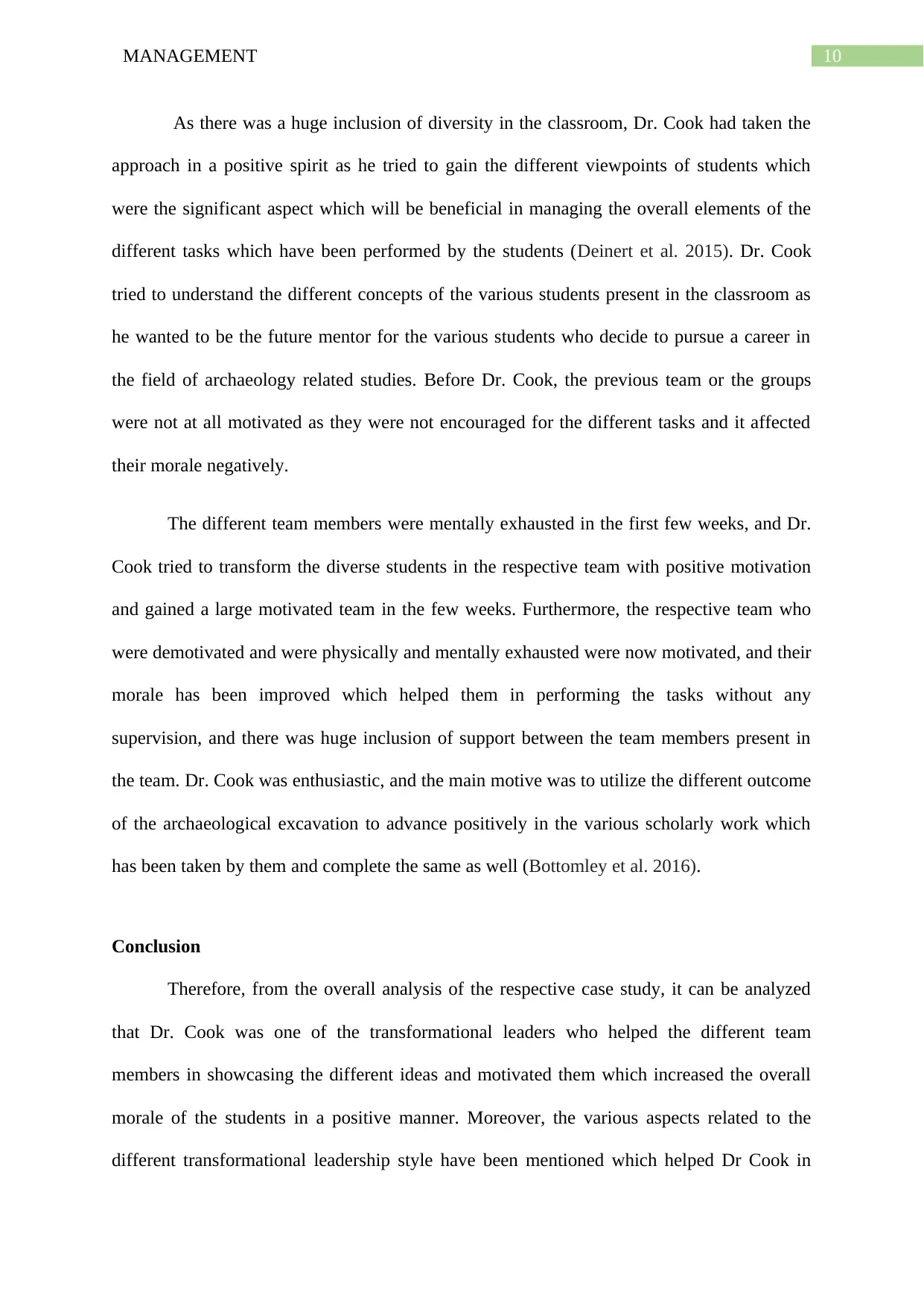
10MANAGEMENT
As there was a huge inclusion of diversity in the classroom, Dr. Cook had taken the
approach in a positive spirit as he tried to gain the different viewpoints of students which
were the significant aspect which will be beneficial in managing the overall elements of the
different tasks which have been performed by the students (Deinert et al. 2015). Dr. Cook
tried to understand the different concepts of the various students present in the classroom as
he wanted to be the future mentor for the various students who decide to pursue a career in
the field of archaeology related studies. Before Dr. Cook, the previous team or the groups
were not at all motivated as they were not encouraged for the different tasks and it affected
their morale negatively.
The different team members were mentally exhausted in the first few weeks, and Dr.
Cook tried to transform the diverse students in the respective team with positive motivation
and gained a large motivated team in the few weeks. Furthermore, the respective team who
were demotivated and were physically and mentally exhausted were now motivated, and their
morale has been improved which helped them in performing the tasks without any
supervision, and there was huge inclusion of support between the team members present in
the team. Dr. Cook was enthusiastic, and the main motive was to utilize the different outcome
of the archaeological excavation to advance positively in the various scholarly work which
has been taken by them and complete the same as well (Bottomley et al. 2016).
Conclusion
Therefore, from the overall analysis of the respective case study, it can be analyzed
that Dr. Cook was one of the transformational leaders who helped the different team
members in showcasing the different ideas and motivated them which increased the overall
morale of the students in a positive manner. Moreover, the various aspects related to the
different transformational leadership style have been mentioned which helped Dr Cook in
As there was a huge inclusion of diversity in the classroom, Dr. Cook had taken the
approach in a positive spirit as he tried to gain the different viewpoints of students which
were the significant aspect which will be beneficial in managing the overall elements of the
different tasks which have been performed by the students (Deinert et al. 2015). Dr. Cook
tried to understand the different concepts of the various students present in the classroom as
he wanted to be the future mentor for the various students who decide to pursue a career in
the field of archaeology related studies. Before Dr. Cook, the previous team or the groups
were not at all motivated as they were not encouraged for the different tasks and it affected
their morale negatively.
The different team members were mentally exhausted in the first few weeks, and Dr.
Cook tried to transform the diverse students in the respective team with positive motivation
and gained a large motivated team in the few weeks. Furthermore, the respective team who
were demotivated and were physically and mentally exhausted were now motivated, and their
morale has been improved which helped them in performing the tasks without any
supervision, and there was huge inclusion of support between the team members present in
the team. Dr. Cook was enthusiastic, and the main motive was to utilize the different outcome
of the archaeological excavation to advance positively in the various scholarly work which
has been taken by them and complete the same as well (Bottomley et al. 2016).
Conclusion
Therefore, from the overall analysis of the respective case study, it can be analyzed
that Dr. Cook was one of the transformational leaders who helped the different team
members in showcasing the different ideas and motivated them which increased the overall
morale of the students in a positive manner. Moreover, the various aspects related to the
different transformational leadership style have been mentioned which helped Dr Cook in
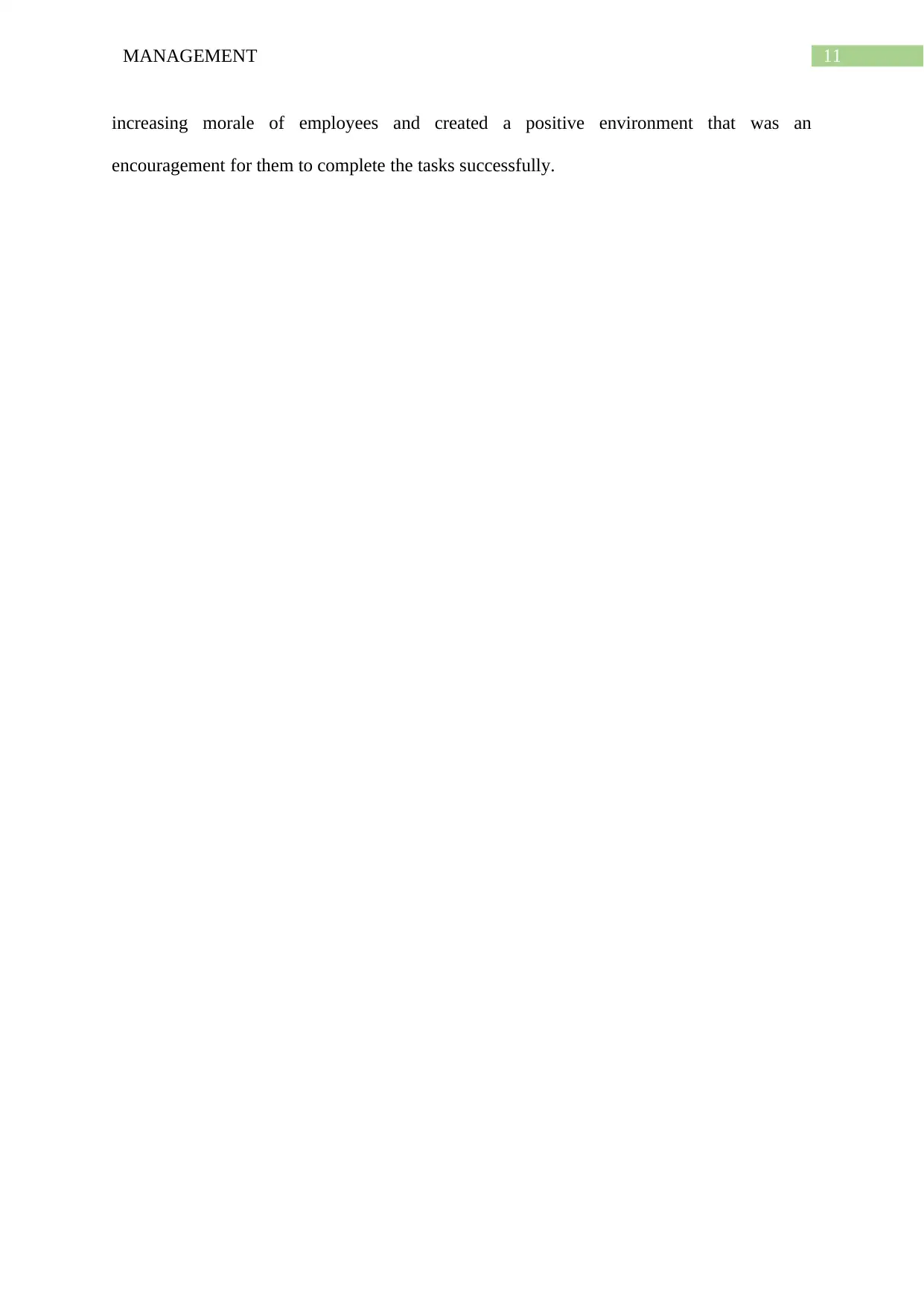
11MANAGEMENT
increasing morale of employees and created a positive environment that was an
encouragement for them to complete the tasks successfully.
increasing morale of employees and created a positive environment that was an
encouragement for them to complete the tasks successfully.

12MANAGEMENT
References
Allen, N., Grigsby, B. and Peters, M.L., 2015. Does Leadership Matter? Examining the
Relationship between Transformational Leadership, School Climate, and Student
Achievement. International Journal of Educational Leadership Preparation, 10(2), pp.1-22.
Banks, G.C., McCauley, K.D., Gardner, W.L. and Guler, C.E., 2016. A meta-analytic review
of authentic and transformational leadership: A test for redundancy. The Leadership
Quarterly, 27(4), pp.634-652.
Boamah, S.A., Laschinger, H.K.S., Wong, C. and Clarke, S., 2018. Effect of transformational
leadership on job satisfaction and patient safety outcomes. Nursing Outlook, 66(2), pp.180-
189.
Bottomley, P., Mostafa, A.M.S., Gould‐Williams, J.S. and León‐Cázares, F., 2016. The
impact of transformational leadership on organizational citizenship behaviours: The
contingent role of public service motivation. British Journal of Management, 27(2), pp.390-
405.
Deinert, A., Homan, A.C., Boer, D., Voelpel, S.C. and Gutermann, D., 2015.
Transformational leadership sub-dimensions and their link to leaders' personality and
performance. The Leadership Quarterly, 26(6), pp.1095-1120.
Donohoe, M. and Kelloway, E.K., 2016. Transformational leadership training for managers:
effects on employee well-being. In Creating Healthy Workplaces (pp. 231-248). Routledge.
Eberly, M.B., Bluhm, D.J., Guarana, C., Avolio, B.J. and Hannah, S.T., 2017. Staying after
the storm: How transformational leadership relates to follower turnover intentions in extreme
contexts. Journal of Vocational Behavior, 102, pp.72-85.
References
Allen, N., Grigsby, B. and Peters, M.L., 2015. Does Leadership Matter? Examining the
Relationship between Transformational Leadership, School Climate, and Student
Achievement. International Journal of Educational Leadership Preparation, 10(2), pp.1-22.
Banks, G.C., McCauley, K.D., Gardner, W.L. and Guler, C.E., 2016. A meta-analytic review
of authentic and transformational leadership: A test for redundancy. The Leadership
Quarterly, 27(4), pp.634-652.
Boamah, S.A., Laschinger, H.K.S., Wong, C. and Clarke, S., 2018. Effect of transformational
leadership on job satisfaction and patient safety outcomes. Nursing Outlook, 66(2), pp.180-
189.
Bottomley, P., Mostafa, A.M.S., Gould‐Williams, J.S. and León‐Cázares, F., 2016. The
impact of transformational leadership on organizational citizenship behaviours: The
contingent role of public service motivation. British Journal of Management, 27(2), pp.390-
405.
Deinert, A., Homan, A.C., Boer, D., Voelpel, S.C. and Gutermann, D., 2015.
Transformational leadership sub-dimensions and their link to leaders' personality and
performance. The Leadership Quarterly, 26(6), pp.1095-1120.
Donohoe, M. and Kelloway, E.K., 2016. Transformational leadership training for managers:
effects on employee well-being. In Creating Healthy Workplaces (pp. 231-248). Routledge.
Eberly, M.B., Bluhm, D.J., Guarana, C., Avolio, B.J. and Hannah, S.T., 2017. Staying after
the storm: How transformational leadership relates to follower turnover intentions in extreme
contexts. Journal of Vocational Behavior, 102, pp.72-85.
Paraphrase This Document
Need a fresh take? Get an instant paraphrase of this document with our AI Paraphraser

13MANAGEMENT
Engelen, A., Gupta, V., Strenger, L. and Brettel, M., 2015. Entrepreneurial orientation, firm
performance, and the moderating role of transformational leadership behaviors. Journal of
Management, 41(4), pp.1069-1097.
Ghasabeh, M.S., Soosay, C. and Reaiche, C., 2015. The emerging role of transformational
leadership. The Journal of Developing Areas, 49(6), pp.459-467.
Hawkins, P., 2017. Leadership team coaching: Developing collective transformational
leadership. Kogan Page Publishers.
Hetland, J., Hetland, H., Bakker, A.B. and Demerouti, E., 2018. Daily transformational
leadership and employee job crafting: The role of promotion focus. European Management
Journal, 36(6), pp.746-756.
Hoch, J.E., Bommer, W.H., Dulebohn, J.H. and Wu, D., 2018. Do ethical, authentic, and
servant leadership explain variance above and beyond transformational leadership? A meta-
analysis. Journal of Management, 44(2), pp.501-529.
Jaiswal, N.K. and Dhar, R.L., 2015. Transformational leadership, innovation climate, creative
self-efficacy and employee creativity: A multilevel study. International Journal of
Hospitality Management, 51, pp.30-41.
Jin, S., Seo, M.G. and Shapiro, D.L., 2016. Do happy leaders lead better? Affective and
attitudinal antecedents of transformational leadership. The Leadership Quarterly, 27(1),
pp.64-84.
Mathew, M. and Gupta, K.S., 2015. Transformational leadership: Emotional
intelligence. SCMS Journal of Indian Management, 12(2), p.75.
Engelen, A., Gupta, V., Strenger, L. and Brettel, M., 2015. Entrepreneurial orientation, firm
performance, and the moderating role of transformational leadership behaviors. Journal of
Management, 41(4), pp.1069-1097.
Ghasabeh, M.S., Soosay, C. and Reaiche, C., 2015. The emerging role of transformational
leadership. The Journal of Developing Areas, 49(6), pp.459-467.
Hawkins, P., 2017. Leadership team coaching: Developing collective transformational
leadership. Kogan Page Publishers.
Hetland, J., Hetland, H., Bakker, A.B. and Demerouti, E., 2018. Daily transformational
leadership and employee job crafting: The role of promotion focus. European Management
Journal, 36(6), pp.746-756.
Hoch, J.E., Bommer, W.H., Dulebohn, J.H. and Wu, D., 2018. Do ethical, authentic, and
servant leadership explain variance above and beyond transformational leadership? A meta-
analysis. Journal of Management, 44(2), pp.501-529.
Jaiswal, N.K. and Dhar, R.L., 2015. Transformational leadership, innovation climate, creative
self-efficacy and employee creativity: A multilevel study. International Journal of
Hospitality Management, 51, pp.30-41.
Jin, S., Seo, M.G. and Shapiro, D.L., 2016. Do happy leaders lead better? Affective and
attitudinal antecedents of transformational leadership. The Leadership Quarterly, 27(1),
pp.64-84.
Mathew, M. and Gupta, K.S., 2015. Transformational leadership: Emotional
intelligence. SCMS Journal of Indian Management, 12(2), p.75.

14MANAGEMENT
Mittal, S. and Dhar, R.L., 2015. Transformational leadership and employee creativity:
mediating role of creative self-efficacy and moderating role of knowledge
sharing. Management Decision, 53(5), pp.894-910.
Nguyen, T.T., Mia, L., Winata, L. and Chong, V.K., 2017. Effect of transformational-
leadership style and management control system on managerial performance. Journal of
Business Research, 70, pp.202-213.
Rosenbach, W.E., 2018. Contemporary issues in leadership. Routledge.
Schmitt, A., Den Hartog, D.N. and Belschak, F.D., 2016. Transformational leadership and
proactive work behaviour: A moderated mediation model including work engagement and
job strain. Journal of occupational and organizational psychology, 89(3), pp.588-610.
Tepper, B.J., Dimotakis, N., Lambert, L.S., Koopman, J., Matta, F.K., Man Park, H. and Goo,
W., 2018. Examining Follower Responses to Transformational Leadership from a Dynamic,
Person–Environment Fit Perspective. Academy of Management Journal, 61(4), pp.1343-
1368.
Wang, H.J., Demerouti, E. and Le Blanc, P., 2017. Transformational leadership, adaptability,
and job crafting: The moderating role of organizational identification. Journal of Vocational
Behavior, 100, pp.185-195.
Willis, S., Clarke, S. and O'Connor, E., 2017. Contextualizing leadership: Transformational
leadership and Management‐By‐Exception‐Active in safety‐critical contexts. Journal of
Occupational and Organizational Psychology, 90(3), pp.281-305.
Mittal, S. and Dhar, R.L., 2015. Transformational leadership and employee creativity:
mediating role of creative self-efficacy and moderating role of knowledge
sharing. Management Decision, 53(5), pp.894-910.
Nguyen, T.T., Mia, L., Winata, L. and Chong, V.K., 2017. Effect of transformational-
leadership style and management control system on managerial performance. Journal of
Business Research, 70, pp.202-213.
Rosenbach, W.E., 2018. Contemporary issues in leadership. Routledge.
Schmitt, A., Den Hartog, D.N. and Belschak, F.D., 2016. Transformational leadership and
proactive work behaviour: A moderated mediation model including work engagement and
job strain. Journal of occupational and organizational psychology, 89(3), pp.588-610.
Tepper, B.J., Dimotakis, N., Lambert, L.S., Koopman, J., Matta, F.K., Man Park, H. and Goo,
W., 2018. Examining Follower Responses to Transformational Leadership from a Dynamic,
Person–Environment Fit Perspective. Academy of Management Journal, 61(4), pp.1343-
1368.
Wang, H.J., Demerouti, E. and Le Blanc, P., 2017. Transformational leadership, adaptability,
and job crafting: The moderating role of organizational identification. Journal of Vocational
Behavior, 100, pp.185-195.
Willis, S., Clarke, S. and O'Connor, E., 2017. Contextualizing leadership: Transformational
leadership and Management‐By‐Exception‐Active in safety‐critical contexts. Journal of
Occupational and Organizational Psychology, 90(3), pp.281-305.
1 out of 15
Related Documents
Your All-in-One AI-Powered Toolkit for Academic Success.
+13062052269
info@desklib.com
Available 24*7 on WhatsApp / Email
![[object Object]](/_next/static/media/star-bottom.7253800d.svg)
Unlock your academic potential
© 2024 | Zucol Services PVT LTD | All rights reserved.



